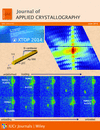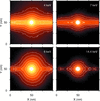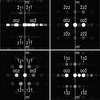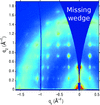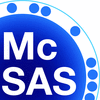issue contents
June 2015 issue

Cover illustration: Calculated coherent X-ray diffraction patterns for (left) perfect and (right) dissociated edge dislocations in a copper nanocrystal. Courtesy of Dupraz et al. [J. Appl. Cryst. (2015), 48, 621–644].
editorial
Open  access
access
 access
accessThe latest virtual special issue of Journal of Applied Crystallography includes some highlights of the 12th Conference on High-Resolution X-ray Diffraction and Imaging (XTOP), which took place in Villard-de-Lans and Grenoble in September 2014.
research papers
Open  access
access
 access
accessCrystal defects can be identified by their fingerprint in coherent X-ray diffraction patterns. Realistic defects in face-centred cubic nanocrystals are studied numerically, revealing various signatures in diffraction patterns depending on the Miller indices and providing an identification method.
Open  access
access
 access
accessRocking curve imaging (projection and section X-ray topography) has been used to study different kinds of defects such as precipitates, dislocations and twins in directionally solidified mono-like silicon ingots. The qualitative and quantitative information extracted from the reconstructed integrated intensity, FWHM and peak position maps provides clues about the initial stages of silicon growth.
Open  access
access
 access
accessThe generalization of the theoretical approach suggested by Kaganer et al. [Phys. Rev. B, (1997), 55, 1793–1810] to an arbitrary surface orientation, arbitrary dislocation line direction and noncoplanar measurement scheme was developed. It was applied to study the dislocation microstructure of Ge films on Si(011) and Si(111) based on a set of reciprocal space maps and profiles measured in noncoplanar geometry.
Open  access
access
 access
accessIt is demonstrated that crystals with curved diffracting planes made of relatively light elements, such as silicon, germanium and gallium arsenide, in the Laue diffraction geometry and in an energy range between 60 and 600 keV can reach a higher diffraction efficiency than more dense mosaic crystals such as copper, silver and gold. In particular, self-standing curved crystals can be used as elements in γ-ray lenses.
Open  access
access
 access
accessBoth optical microscopy with polarized light and polychromatic beam synchrotron X-ray diffraction imaging (white-beam topography) are used to study in situ the way an ice single-crystal deforms.
Open  access
access
 access
accessA method for the simulation of the diffractometer instrumental function for high-resolution X-ray diffraction, applicable for coplanar and noncoplanar measurement geometry and for any combination of X-ray optical elements, is proposed. Good agreement is demonstrated between the measured and the simulated reciprocal-space maps, which account for the instrumental function.
Open  access
access
 access
accessMonte Carlo simulation of the dose distribution in water around magnetite nanoparticles irradiated by monochromatic X-rays is presented.
Open  access
access
 access
accessStructural changes in vertebrate bone tissues caused by bone growth or by weightlessness were studied using a combination of X-ray tomography at different wavelengths and X-ray fluorescence analysis.
Open  access
access
 access
accessA laboratory X-ray diffraction setup is reported, which allows quantitative characterization of the microtwin and antiphase domain densities in epitaxial GaP/Si thin layers.
A combination of a hydrothermal diamond anvil cell and synchrotron X-ray diffraction is utilized to perform in situ isochronal annealing and thermal expansion studies on swift heavy ion irradiated CeO2 and ThO2.
Download citation


Download citation


A fast and fully automatic procedure for collecting electron diffraction tomography data suitable for structure solution is presented.
CCDC reference: 1052528
Download citation


Download citation


A gemini surfactant with a biphenyl spacer can spontaneously form a crystal with a lamellar character at the air/liquid interface.
CCDC reference: 1053701
The appropriate zone-axis orientations for polarity determination via a single zone-axis convergent-beam electron diffraction (CBED) pattern are deduced for 19 of the 25 polar point groups. The validity of the CBED method is confirmed both by experiment and by calculation of CBED patterns.
Open  access
access
 access
accessAn automated method has been developed to characterize the type and spatial distribution of twinning in crystal orientation maps from synchrotron X-ray Laue microdiffraction results.
Recrystallization can be an effective method for improving the quality of protein crystals. Experimental studies have verified that recrystallization not only enhanced the morphology of the crystals but also improved crystal quality. Therefore, it is proposed that recrystallization might be a useful alternative method for obtaining protein crystals with enhanced diffraction.
X-ray powder diffraction has been used to evaluate the influence of sample preparation on the microstructure of dental hydroxyapatite. These results point out the most appropriate extraction technique for enamel specimens.
Differential ultracentrifugation coupled to small-angle X-ray scattering on macromolecular complexes
A new method is described for collecting small-angle X-ray scattering data from samples while they are fractionated after differential ultracentrifugation. This may enable solution structural studies on a host of large macromolecular complexes for the first time.
This paper presents the rotation contour contrast (RCC) in backscattered electron (BSE) micrographs of a deformed specimen. Using electron backscatter diffraction, a model was developed and validated to link the rotation of crystal planes to the channeling contrast in the channeling pattern and. consequently, RCC in the BSE micrograph.
Element-specific structural studies of Si/B4C buried interfaces were carried out using resonant soft X-ray reflectivity. This approach enabled us to construct a quantitative interfacial map of the element-sensitive structural profile with a precision of a few atomic percent on the nanometre length scale.
The fidelity of the crystal orientations and disorientations obtained by the classical two-dimensional Hough-transform-based EBSD method is investigated.
A bimodal size distribution of goethite crystals is estimated from their X-ray powder diffraction line profile. This enables monitoring of the acid-leaching performance for two distinct goethite size fractions.
In order to interpret the transformation kinetics of gypsum, formed by flue gas desulfurization, to the hemihydrate in an isothermal batch crystallizer, nonlinear optimization was employed to solve a model based on horizontally translating the crystal size distribution during the transformation process.
This article presents a detailed micro/mesoscopic structural analysis of doped calcium titanate nanoparticles using small-angle neutron scattering and X-ray diffraction techniques. The effects of doping on the optical properties are also investigated.
Download citation


Download citation


A hydrogen-bonded supramolecular architecture, leading to superior nonlinear optical activity, is observed in ammonium 2,4-dinitrophenolate hydrate.
CCDC reference: 1012355
An X-ray diffraction method is developed for the determination of the distribution of temperature and interplanar spacing in a single-crystal plate.
New methods for the quantitative evaluation of averaged dummy atom models resulting from small-angle X-ray scattering ab initio shape retrieval programs such as DAMMIN are presented. The techniques are validated for model systems with distinct shapes and size distributions, enabling the use of bead-modelling software for inorganic nanocrystals.
Calculating millions of Gaussians three orders of magnitude faster than alternative methods should allow for the refinement of large structural models using the atomic pair distribution function. Central to the success of the method are very accurate representations of Gaussians and fast convolutions.
A wide field of view X-ray microscope based on grazing incidence diffraction on bent perfect silicon wafers has been developed and tested.
An algorithm for the extraction of grain-by-grain domain volume fractions in polycrystalline ferroic materials using the three-dimensional X-ray diffraction method is presented. Here, the volume fraction information is used to calculate a grain-scale non-180° ferroelectric domain switching strain in two example electroceramic materials.
The grain-refining mechanism of cast zinc through copper inoculation is described, and the hexagonal close packing orientation relationship in zinc–copper alloys is identified using electron backscatter diffraction, an Euler-based numerical method and the edge-to-edge crystallographic matching model.
teaching and education
Free 

A teaching tool for X-ray crystallography using a one dimensional approach is presented.
short communications
Fully ab initio crystal structure prediction of NiSi was carried out and a new high-pressure phase was discovered. This phase is a tetragonal distortion of the CsCl-type structure and it is stable in the pressure range 213–522 GPa.
Download citation


Download citation


A simple Schiff base molecule was found to form different types of crystalline framework, which show potential selectivity for uptake of small guest molecules.
Open  access
access
 access
accessProtein crystals have been subjected to a vacuum pressure of 10−5 mbar prior to flash-cooling, and data acquired at either 7 or 13 keV.
computer programs
A MATLAB-based toolbox was developed to visualize and process grazing-incidence X-ray scattering data from surfaces and thin films. Three-dimensional nanostructures in thin films can also be indexed.
Open  access
access
 access
accessSynchWeb significantly simplifies sample registration and is targeted towards live data collection monitoring and remote access for macromolecular crystallography.
Open  access
access
 access
accessThe new computer program DSR enables semi-automatic modelling of disordered or well ordered moieties in crystal structures via a placement procedure of molecular fragments and corresponding stereochemical restraints from a database.
An online server has been created to compute the diffraction precision index and thereby estimate the atomic coordinate errors of non-covalent interactions in a given three-dimensional structure. The widespread false-precision representation of protein crystal structures could be considered an issue for the field of protein crystallography and the aim of this work is to try to ensure that this practice is eradicated.
A code named AniCryDe to calculate the anisotropic elastic properties in a silicon or germanium crystal has been released. For the selected crystallographic orientation, AniCryDe calculates several key mechanical parameters. The program has a user-friendly interface that makes it readily operational and intuitive.
XISF is a MATLAB program developed to separate intermolecular structure factors from total X-ray scattering structure factors for molecular liquids and amorphous solids.
Open  access
access
 access
accessThe SCT suite of tools for the atomistic modelling of X-ray and neutron scattering curves has resulted in 77 macromolecular structures to date. SCT is now made publicly available as open source, alongside an easier-to-use reimplementation of the same algorithms in Python.
Open  access
access
 access
accessA user-friendly open-source Monte Carlo regression package (McSAS) is presented, which aids in the analysis of scattering patterns from uncorrelated, shape-similar scatterers. The Monte Carlo nature necessitates an assumption on the elementary shape of the scatterer, but can resolve the shape-defining parameter distributions without restrictions on the mathematical form of the distribution.
laboratory notes
The new stroboscopic MAD-STROBO data acquisition system was developed to measure profiles of high-resolution X-ray powder diffraction under a dynamically applied electric field. The possibility of detecting sub-millidegree shifts of Bragg reflections with a microsecond time resolution is demonstrated.
addenda and errata
Free 

The affiliations for the authors of J. Appl. Cryst. (2011), 44, 1157–1163 are corrected.
crystallographers
Free 


 journal menu
journal menu








